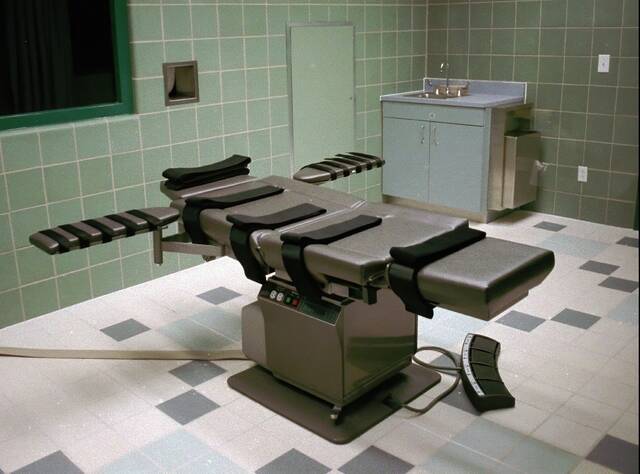Attorney Casey White has seen youth violence surge. Since the North Hills native launched his career 13 years ago as a criminal defense lawyer in Pittsburgh, he has witnessed gun violence involving children and teens grow exponentially. He said he has never had as many juvenile clients in jail awaiting trial for shootings and gun-possession charges as he does now.
“Some of these juveniles, they’re so desensitized to gun violence, it kind of takes you aback a little bit,” White said. “It’s just a way of life to them.”
Gun violence nationwide, especially among juveniles, has been on the rise for about five years, and the covid-19 pandemic did little to stem the growing numbers, experts said. Southwestern Pennsylvania is part of the trend.
Gun deaths among children and teens nationwide rose 50% in just two years, from 1,732 in 2019 to 2,590 in 2021, according to mortality data from the U.S. Centers for Disease Control and Prevention. Nearly 85% of those killed were male, and 67% were Black.
More than 170 juveniles have died from gun violence in Pittsburgh since 2018, according to data obtained by TribLive following a Right to Know Law request. Guns killed 45 juveniles in Pittsburgh in 2022 — more than double the 2020 figure of 22 deaths, the data showed. Through October of this year, juvenile gun deaths had totaled 30.
The most common of age for Pittsburgh juveniles recently killed by guns is 17; there have been at least 48 of those deaths in the past five years, the data showed. Three of the shooting victims hadn’t celebrated their first birthday. Four more never made it to a second birthday.
The examples seem endless.
In late October, Pittsburgh teenager Timothy Whitfield accepted a plea deal for murdering Central Catholic High School student Jafar Brooks, 15, three years ago outside a Penn Hills apartment complex. Whitfield was 16 at the time of the murder.
On Oct. 8, multiple shooters opened fire at an Indiana County party in what state police described as a mass shooting, killing one man and wounding eight others, ages 18 to 23.
Weeks later, a 15-year-old Wilmerding boy died after being shot in the head in the borough.
Six juveniles and young men will head to Westmoreland County Common Pleas court Monday after, authorities said, they ambushed a 39-year-old New Kensington man, shooting him 11 times, over drug money on July 3, 2022. Authorities believe a 14-year-old boy used a rifle to fire the fatal shot. Jury selection begins Dec. 4.
Nearly 49,000 people were killed by guns in the United States in 2021, a 23% increase over 2019 figures, CDC data showed. More than 8 in 10 murders in 2021 involved a firearm, a 45% increase from prepandemic numbers.
Children and teens are increasingly the shooters.
“The rates of gun violence have gone through the roof, particularly with children,” said Warren S. Eller, a criminology expert who teaches at John Jay College of Criminal Justice in New York City.
Youth gun violence nationwide escalated throughout the 1980s, peaking in most American cities around 1991 or 1992, Eller said. Trauma experts say Pittsburgh mirrored those national trends, with city police grappling with gang violence in the early 1990s.
For nearly two decades that followed, though, gun violence dissipated, until reports of gun crime among those younger than 18 started to escalate about five years ago, Eller said.
“It’s an alarming trend we have,” he said.
In 2020, gun violence became American children’s leading cause of death, surpassing car accidents for the first time, CDC data showed.
The problem is not assault-style rifles, contrary to what some elected officials say, Eller said.
“The buzzword — you hear it from the White House and you hear it from others — is that the AR-15 is the weapon of choice, and it’s just not,” he said. “We have a problem with handguns.”
Shooters used rifles, including models such as the AR-15, in 24% of mass shootings in the United States since 1998, Eller said. Handguns were used at least 54% of the time.
“People like to talk about assault-rifle bans, but people don’t typically get shot by rifles,” he said. “Unless (shooters) are going on one-way trips, it tends not to be the weapon of choice.”
Local cases of youth violence
Western Pennsylvania offers myriad stories of young lives shattered by gun violence. Among the incidents:
• Two teens were killed and eight injured on Easter Sunday 2022 when gunfire broke out at a party of 200 people at an Airbnb rental on Pittsburgh’s North Side.
• Months later, teens gunned down three Pittsburghers at an Allegheny Center bus stop. At a funeral for one of the victims, teens retaliated, shooting five at a Brighton Heights church.
• Earlier this year, on Valentine’s Day, two teens shot four students at a Homewood school. In May, a 15-year-old boy fatally shot his Oliver Citywide Academy classmate.
“We haven’t been able to tackle this issue because we’re not addressing the roots of it,” said T. Rashad Byrdsong, founder of the Homewood-based Community Empowerment Association, which provides structure and support for at-risk youth and families in Pittsburgh’s distressed and marginalized communities. “This is a public health issue. This is a public health crisis.”
Nationwide, youth gun violence disproportionately has killed Black children and teens, who remain about six times more likely to die from a gun injury than their white peers, CDC data showed.
From 2018 to 2021, the number of children killed by firearms rose more than 40%, according to an American Academy of Pediatrics study released in September.
Locally, more and more teenagers are being caught carrying guns. A Pittsburgh Bureau of Police spreadsheet logging firearms-related charges against juveniles since 2011 runs for more than 1,600 lines.
Pittsburgh police arrested 135 juveniles through October of this year on firearms-related charges compared to about 120 juveniles in all of 2022, data showed. In 2018, the year-ending total was 61.
On the rise
Pennsylvania is no stranger to youth gun violence.
Half of all child and teen gun deaths nationwide during the covid-19 pandemic occurred in just 10 states — one of those was Pennsylvania, where more than 1,200 such deaths were reported from 2011 to 2021, CDC data showed.
In Westmoreland County, state police charged three Hempfield teens, ages 15 and 16, with gun possession after an Oct. 2 incident in which authorities said the students passed two loaded handguns — a .38-caliber gun and a .22-caliber weapon — on a school bus and in a high school bathroom. Investigators said both firearms were stolen.
The FBI Crime Data Explorer dives deeper, though its data reflects only incidents self-reported by about 85% 0f Pennsylvania’s law enforcement agencies. Data shows handguns were used in more than 6,300 violent crimes in Pennsylvania in 2022. That’s up from 4,678 violent crimes one year earlier.
There were more than 600 homicides in Pennsylvania last year — and a gun was used in more than 4 out of every 5 killings, FBI data showed. More than 100 of those homicides involved children and teens ages 10 to 19.
Eller recognizes the “alarming trend” in youth violence.
“But the question is not, ‘Why did the 14-year-old shoot someone?’,” Eller said. “It’s, ‘Why did the 14-year-old feel he needed a gun in the first place?’”
The Shuman Center issue
Several people who deal with youth violence said part of the problem in Allegheny County is a shuttered Shuman Center.
The former juvenile detention center — a 47-year-old, county-run facility in Pittsburgh’s Lincoln-Lemington-Belmar neighborhood — closed in 2021 after the state Department of Human Services revoked its license. The campus held children and teens being tried for crimes in juvenile court and also provided education and social services.
Allegheny County officials announced Sept. 15 that Latrobe-based Adelphoi would take over detention services at the center as soon as January.
“The reality of it is there’s no consequences,” Pittsburgh police Chief Larry Scirotto said of the center’s closure. “I hear from my officers all the time that these kids say, ‘I don’t care because Shuman doesn’t exist.’”
White said he “has never had this many juveniles in Allegheny County Jail in my entire career — and it’s related to gun violence.”
“With Shuman Center closed, these kids are just being put out on the street,” White said. “I think that has an effect on gun violence. When a kid commits a crime and doesn’t get slapped on the wrist, they keep testing the waters.”
Scirotto said gun culture is more pervasive now among Pittsburgh youth than it was eight years ago when he took over Pittsburgh’s major crimes unit, which investigates homicides.
Still, Scirotto stressed that “random acts of gun violence are very few and far between” in the city.
Homicides in Pittsburgh are down 22% this year to date, Scirotto said. Nonfatal shootings are down 17%.
“The violence within the city, it has lessened,” he said. “The root cause of that? Sometimes it’s difficult to figure out. But our officers are proactive — I’ve made that message clear.”
A call for reform
Community leaders need a multipronged approach to address youth gun violence, Byrdsong said.
“You have to start with the family, with early childhood development,” he said. “We have to make sure we can get people out of poverty and give incentives for fathers to stick around.”
The Community Empowerment Association, which he formed in 1993, provides after-school programming to keep kids off the streets and away from drugs and crime, Byrdsong said. Volunteers there talk about anger management and impulse control.
Based in the former Holy Rosary School on Homewood’s Kelly Street, the association serves Pittsburgh neighborhoods such as Homewood, Larimer and Lincoln-Lemington as well as suburban communities like Wilkinsburg, McKeesport and Braddock.
While Byrdsong’s work focuses on helping at-risk youth and families, he has been personally affected by youth violence.
Brooks, the Central Catholic teen slain in Penn Hills in late 2020, was his grandson. The teen’s killer recently was sentenced to 7½ to 15 years in prison after a third-degree murder plea.
Byrdsong, a Vietnam veteran raised in Braddock and Homewood, cites family as key to stemming the gun violence pandemic.
“You can’t work with young people in isolation of family, in isolation of survivors, in isolation of community,” he said. “And we need to ensure the basics. Ensure housing. Ensure jobs. Ensure kids staying in school. There has to be reform across the board.”
The role of drugs
Lifelong New Kensington resident John Peck joined the Westmoreland County District Attorney’s Office in 1981. He led the agency from 1994 until his retirement last year.
Today, the father of two fills in as a hearing officer in Westmoreland County juvenile court. He said he hears about more youth violence than he did a generation ago.
He couldn’t cite statistics, but Peck was quick to rattle off incidents of youth violence that have been burned into his memory.
About 13 or 14 years ago, the District Attorney’s Office prosecuted five people, at least two of them juveniles, who ambushed an Armstrong County drug dealer, then took him to rural Bell Township and fatally shot him about a dozen times, Peck said.
A few years later, several young people, including at least one juvenile, lured a mentally disabled woman into a Greensburg-area residence, tortured her for three or four days, then killed her, Peck said. The crime was initiated by a 17-year-old girl.
“It wasn’t something that was completely random,” he said. “A lot of times, it starts over drug dealing.”
Westmoreland County Detective Tony Marcocci said when he’s handling drug investigations, he is seeing more and more juveniles with guns.
“I think that a lot of it is due to social media,” said Marcocci, who called online posts with “lots of money, guns and women” a kind of status symbol. He called it a major concern.
It’s “a machismo thing,” Marcocci said. Teens think having a gun tells others what they’re willing to do, he said.
“Gone are the days of people actually settling a squabble with hands,” he said.
Overall, Peck said he feels many Westmoreland County communities are insulated from these crime trends because of their remoteness.
His two adult children went to public schools in Westmoreland County and never felt threatened by gun violence, he said.
“I think it’s roughly the same today,” Peck said. “There’s more instances of gunfire … but the schools were never the target.”
Becoming desensitized
The work never stops at Pittsburgh’s Center for Traumatic Stress In Children and Adolescents.
Clinical psychologist Anthony P. Mannarino opened the North Side trauma center 30 years ago in the midst of an early-1990s epidemic of gang violence. Drive-by shootings weren’t uncommon near the center, which is located by Allegheny General Hospital, Mannarino recalled.
One thing that has remained constant over the years: Teens continue to attack each other with guns.
“We get kids referred to us every month for gun-related violence,” Mannarino said. “It can be community violence. It can be school-related violence. It can be a shooting in the home.”
His center employs trauma-focused Cognitive Behavioral Therapy, a model he helped develop, to ease the impact of violence away from victims’ long-term memories. Doctors and counselors work with victims alongside their families — not in isolation.
“The trauma is not as entrenched as it is with an adult,” he said. “I think you have better chances with a child … at preventing long-term damage. If we never talk with (children and teens), these memories stay inside of them. And it affects their brain, it affects their body.”
The center’s work has been steady since the 1990s, Mannarino said. Clinicians serve about 30 new families a month and up to 400 families each year. Most patients are treated over 12 to 16 sessions, or during four or five months.
“There’s less gang violence, but still there are many incidents of gun violence in communities,” Mannarino said. “On the one hand, I think kids feel unsafe often. On the other side of the coin, though, I see a lot of desensitization. ‘OK, there’s another shooting.’
“Violence has become so prevalent (that) you do get a little desensitized to it because it’s happening on a daily basis.”
Staff writer Renatta Signorini contributed to this report.








